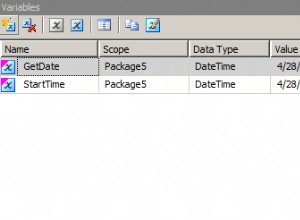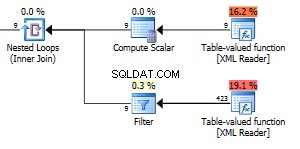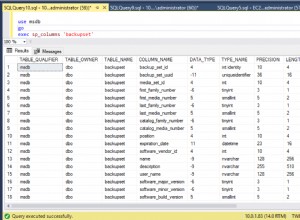Tablas de base de datos
Suponiendo que tiene las siguientes dos tablas:
CREATE TABLE old_post (
id int8 NOT NULL,
title varchar(255),
version int4 NOT NULL,
PRIMARY KEY (id)
)
CREATE TABLE post (
id int8 NOT NULL,
created_on date,
title varchar(255),
version int4 NOT NULL,
PRIMARY KEY (id)
)
Entidad JPA
El old_post la tabla debe replicarse con la nueva post . Tenga en cuenta que la post la tabla tiene más columnas ahora que la tabla anterior.
Solo necesitamos mapear la Post entidad:
@Entity(name = "Post")
@Table(name = "post")
public static class Post {
@Id
private Long id;
private String title;
@Column(name = "created_on")
private LocalDate createdOn = LocalDate.now();
@Version
private int version;
//Getters and setters omitted for brevity
}
Oyentes de eventos de Hibernate
Ahora, tenemos que registrar 3 detectores de eventos para interceptar las operaciones INSERT, UPDATE y DELETE para el Post entidad.
Podemos hacer esto a través de los siguientes detectores de eventos:
public class ReplicationInsertEventListener
implements PostInsertEventListener {
public static final ReplicationInsertEventListener INSTANCE =
new ReplicationInsertEventListener();
@Override
public void onPostInsert(
PostInsertEvent event)
throws HibernateException {
final Object entity = event.getEntity();
if(entity instanceof Post) {
Post post = (Post) entity;
event.getSession().createNativeQuery(
"INSERT INTO old_post (id, title, version) " +
"VALUES (:id, :title, :version)")
.setParameter("id", post.getId())
.setParameter("title", post.getTitle())
.setParameter("version", post.getVersion())
.setFlushMode(FlushMode.MANUAL)
.executeUpdate();
}
}
@Override
public boolean requiresPostCommitHanding(
EntityPersister persister) {
return false;
}
}
public class ReplicationUpdateEventListener
implements PostUpdateEventListener {
public static final ReplicationUpdateEventListener INSTANCE =
new ReplicationUpdateEventListener();
@Override
public void onPostUpdate(
PostUpdateEvent event) {
final Object entity = event.getEntity();
if(entity instanceof Post) {
Post post = (Post) entity;
event.getSession().createNativeQuery(
"UPDATE old_post " +
"SET title = :title, version = :version " +
"WHERE id = :id")
.setParameter("id", post.getId())
.setParameter("title", post.getTitle())
.setParameter("version", post.getVersion())
.setFlushMode(FlushMode.MANUAL)
.executeUpdate();
}
}
@Override
public boolean requiresPostCommitHanding(
EntityPersister persister) {
return false;
}
}
public class ReplicationDeleteEventListener
implements PreDeleteEventListener {
public static final ReplicationDeleteEventListener INSTANCE =
new ReplicationDeleteEventListener();
@Override
public boolean onPreDelete(
PreDeleteEvent event) {
final Object entity = event.getEntity();
if(entity instanceof Post) {
Post post = (Post) entity;
event.getSession().createNativeQuery(
"DELETE FROM old_post " +
"WHERE id = :id")
.setParameter("id", post.getId())
.setFlushMode(FlushMode.MANUAL)
.executeUpdate();
}
return false;
}
}
Los 3 detectores de eventos se pueden registrar usando un Integrator de Hibernate :
public class ReplicationEventListenerIntegrator
implements Integrator {
public static final ReplicationEventListenerIntegrator INSTANCE =
new ReplicationEventListenerIntegrator();
@Override
public void integrate(
Metadata metadata,
SessionFactoryImplementor sessionFactory,
SessionFactoryServiceRegistry serviceRegistry) {
final EventListenerRegistry eventListenerRegistry =
serviceRegistry.getService(EventListenerRegistry.class);
eventListenerRegistry.appendListeners(
EventType.POST_INSERT,
ReplicationInsertEventListener.INSTANCE
);
eventListenerRegistry.appendListeners(
EventType.POST_UPDATE,
ReplicationUpdateEventListener.INSTANCE
);
eventListenerRegistry.appendListeners(
EventType.PRE_DELETE,
ReplicationDeleteEventListener.INSTANCE
);
}
@Override
public void disintegrate(
SessionFactoryImplementor sessionFactory,
SessionFactoryServiceRegistry serviceRegistry) {
}
}
Y, para indicar a Hibernate que use este Integrator personalizado , debe configurar el hibernate.integrator_provider propiedad de configuración:
<property name="hibernate.integrator_provider"
value="com.vladmihalcea.book.hpjp.hibernate.listener.ReplicationEventListenerIntegrator "/>
Tiempo de prueba
Ahora, al persistir una Post entidad:
Post post1 = new Post();
post1.setId(1L);
post1.setTitle(
"The High-Performance Java Persistence book is to be released!"
);
entityManager.persist(post1);
Hibernate ejecutará las siguientes declaraciones SQL INSERT:
Query:["INSERT INTO old_post (id, title, version) VALUES (?, ?, ?)"], Params:[(1, The High-Performance Java Persistence book is to be released!, 0)]
Query:["insert into post (created_on, title, version, id) values (?, ?, ?, ?)"], Params:[(2018-12-12, The High-Performance Java Persistence book is to be released!, 0, 1)]
Al realizar otra transacción que actualiza una Post existente entidad y crea una nueva Post entidad:
Post post1 = entityManager.find(Post.class, 1L);
post1.setTitle(post1.getTitle().replace("to be ", ""));
Post post2 = new Post();
post2.setId(2L);
post2.setTitle(
"The High-Performance Java Persistence book is awesome!"
);
entityManager.persist(post2);
Hibernate replica todas las acciones al old_post mesa también:
Query:["select tablerepli0_.id as id1_1_0_, tablerepli0_.created_on as created_2_1_0_, tablerepli0_.title as title3_1_0_, tablerepli0_.version as version4_1_0_ from post tablerepli0_ where tablerepli0_.id=?"], Params:[(1)]
Query:["INSERT INTO old_post (id, title, version) VALUES (?, ?, ?)"], Params:[(2, The High-Performance Java Persistence book is awesome!, 0)]
Query:["insert into post (created_on, title, version, id) values (?, ?, ?, ?)"], Params:[(2018-12-12, The High-Performance Java Persistence book is awesome!, 0, 2)]
Query:["update post set created_on=?, title=?, version=? where id=? and version=?"], Params:[(2018-12-12, The High-Performance Java Persistence book is released!, 1, 1, 0)]
Query:["UPDATE old_post SET title = ?, version = ? WHERE id = ?"], Params:[(The High-Performance Java Persistence book is released!, 1, 1)]
Al eliminar una Post entidad:
Post post1 = entityManager.getReference(Post.class, 1L);
entityManager.remove(post1);
El old_post el registro también se elimina:
Query:["DELETE FROM old_post WHERE id = ?"], Params:[(1)]
Query:["delete from post where id=? and version=?"], Params:[(1, 1)]
Código disponible en GitHub .




